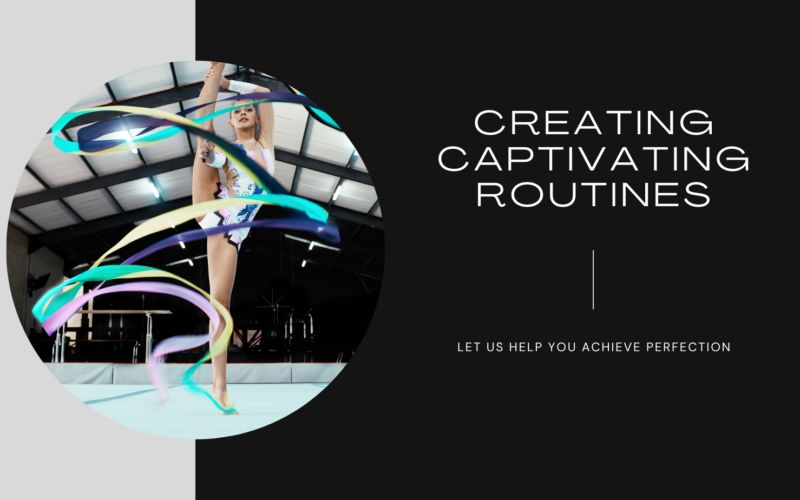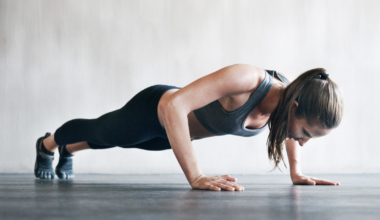Introduction
Gymnastics choreography is the art of creating captivating routines that showcase the athleticism, grace, and artistry of gymnasts.
In competitions, routines are not only judged on technical execution but also on their ability to captivate and engage the audience.
In this article, we will explore the intricate process of gymnastics choreography, from selecting music to choreographing movements and expressing emotion, all aimed at creating routines that leave a lasting impression.
Understanding Gymnastics Elements
Gymnastics routines are composed of a variety of elements, including jumps, turns, balances, and acrobatic skills.
These elements form the foundation of choreography and must be incorporated seamlessly into routines.
Choreographers carefully consider the difficulty level and execution of each element to ensure that routines are challenging yet achievable for the gymnast. Below are some elements:
1. Music Selection and Theme
Music plays a crucial role in setting the tone and atmosphere of gymnastics routines. When selecting music, choreographers consider factors such as tempo, mood, and style to complement the gymnast’s movements and enhance the overall performance.
Additionally, incorporating a theme or storyline can add depth and narrative to the routine, allowing gymnasts to express themselves creatively and emotionally through their movements.
2. Choreography Techniques:
Choreographing gymnastics routines involves a combination of movement patterns, transitions, and formations.
Choreographers use a variety of techniques to create visually appealing sequences that highlight the gymnast’s strengths and showcase their athleticism.
By incorporating variety in movement dynamics, such as speed, direction, and levels, choreographers keep routines dynamic and engaging from start to finish.
3. Artistic Expression and Performance Quality
In addition to technical precision, gymnastics choreography emphasizes artistic expression and performance quality.
Gymnasts are encouraged to convey emotion and personality through their movements, using facial expressions, body language, and stage presence to connect with the audience.
By infusing routines with passion and intensity, gymnasts elevate their performances from mere displays of skill to powerful expressions of artistry.
4. Routine Structure and Composition
Creating a well-structured routine is essential for maximizing its impact and effectiveness. Choreographers carefully plan the structure of the routine, balancing elements of difficulty, execution, and artistry throughout.
By strategically sequencing elements and creating a cohesive flow and rhythm, choreographers ensure that routines are engaging and memorable from beginning to end.
5. Feedback and Revision:
Throughout the choreography process, gymnasts and coaches seek feedback from peers, mentors, and judges to identify areas for improvement.
Analyzing routines for technical errors, artistic nuances, and overall impact allows choreographers to make revisions that enhance the quality and effectiveness of the routine.
By remaining open to feedback and continuously refining their work, gymnasts, and choreographers strive for excellence in their performances.
6. Practice and Rehearsal
Practice and rehearsal are crucial for mastering gymnastics routines and ensuring flawless execution in competition.
Gymnasts break down routines into manageable sections for focused practice, rehearsing under performance conditions to simulate the pressure and intensity of competition.
By dedicating time and effort to rehearsal, gymnasts build confidence, refine their skills, and elevate their performance to the highest level.
7. Adaptation and Flexibility
Flexibility and adaptability are essential qualities in gymnastics choreography, allowing gymnasts and choreographers to respond to changes and challenges as they arise.
Whether adjusting routines to suit the strengths and preferences of individual gymnasts or adapting to changes in competition requirements or regulations, flexibility allows gymnasts to perform at their best under any circumstances.
How Important is Practice and Rehearsal in Gymnastics Choreography?
Practice and rehearsal play a pivotal role in gymnastics choreography, serving as the foundation for flawless execution and captivating performances. Here’s why practice and rehearsal are essential in gymnastics choreography:
1. Refinement of Technique:
Practice and rehearsal allow gymnasts to refine their technique and master the intricacies of each movement within the routine.
By repeating skills and sequences, gymnasts can improve their precision, timing, and control, ensuring that every element of the routine is executed with perfection.
2. Muscle Memory Development:
Consistent practice builds muscle memory, enabling gymnasts to perform routines instinctively and effortlessly.
Through repetition, movements become ingrained in the body, allowing gymnasts to focus on artistic expression and performance quality without having to think about the mechanics of each skill consciously.
3. Building Confidence:
Practice and rehearsal instill confidence in gymnasts, empowering them to perform with poise and assurance on the competition floor.
By rehearsing routines under simulated competition conditions, gymnasts learn to manage nerves, overcome performance anxiety, and deliver their best performances when it matters most.
4. Enhancement of Performance Quality:
Rehearsals provide opportunities for gymnasts to refine their performance quality, including facial expressions, body language, and stage presence.
By rehearsing artistic elements alongside technical skills, gymnasts can convey emotion, tell a story, and captivate audiences with their performances.
5. Identification of Areas for Improvement:
Practice sessions allow gymnasts and coaches to identify areas for improvement and make necessary adjustments to routines. By reviewing footage, receiving feedback, and analyzing performances, gymnasts can refine choreography, troubleshoot technical issues, and optimize routine composition for maximum impact.
6. Consistency in Execution
Regular practice fosters consistency in routine execution, minimizing the risk of errors and maximizing scores in competition.
By rehearsing routines consistently, gymnasts develop a reliable performance style that judges can trust, increasing their chances of success on the competition floor.
7. Adaptation to Changes
Practice and rehearsal prepare gymnasts to adapt to changes in competition settings, such as variations in equipment, lighting, or floor dimensions.
By rehearsing routines in different environments and conditions, gymnasts develop adaptability and resilience, ensuring that they can perform at their best under any circumstances.
8. Team Cohesion: Rehearsing routines as a team fosters camaraderie, collaboration, and cohesion among gymnasts, coaches, and choreographers.
By working together towards a common goal, gymnasts develop trust, communication skills, and a sense of unity that enhances their collective performance on the competition floor.
Why is Gymnastics Choreography Important?
Gymnastics choreography is a vital aspect of the sport that goes beyond mere performance aesthetics. It serves as a platform for athletes to express their artistry, athleticism, and personality while enhancing the overall quality of their routines. Here’s a detailed exploration of why gymnastics choreography is essential:
1. Expression and Artistry: Choreography allows gymnasts to showcase their individuality and creativity on the competition floor.
Through movements, gestures, and expressions, gymnasts can convey emotions, themes, and narratives that engage and captivate audiences.
Choreography adds depth and dimension to routines, transforming them from a series of athletic maneuvers into compelling artistic performances.
2. Musicality and Rhythm: Gymnastics choreography is intricately linked to music, with routines choreographed to synchronize with specific beats, rhythms, and melodies.
Musicality is essential in creating a harmonious blend of movement and music, enhancing the overall impact of the routine. Choreographers carefully select music that complements the gymnast’s style and personality, creating a cohesive and dynamic performance.
3. Enhancing Difficulty and Variety: Choreography plays a crucial role in maximizing the difficulty and variety of gymnastics routines.
By incorporating a diverse range of movements, transitions, and connections, choreographers can challenge gymnasts to push their boundaries and showcase their versatility.
Creative choreography can elevate routine difficulty without compromising execution or form, adding excitement and intrigue to performances.
4. Flow and Continuity: Well-executed choreography ensures smooth transitions between elements, maintaining the flow and continuity of the routine.
Seamless transitions enhance the fluidity and gracefulness of the performance, creating a visually pleasing experience for both judges and spectators.
Choreographers strategically plan movement sequences to optimize the flow of the routine, minimizing pauses or disruptions that could detract from the overall impression.
5. Emphasizing Strengths and Masking Weaknesses: Choreography is tailored to highlight the strengths of each gymnast while minimizing their weaknesses.
Choreographers work closely with athletes to identify their unique strengths, whether it be flexibility, power, or grace, and design routines that showcase these attributes to their fullest potential.
Additionally, choreography can be used strategically to disguise technical weaknesses or limitations, allowing gymnasts to focus on their strengths during competition.
6. Engaging the Audience: Dynamic and expressive choreography captivates audiences and creates memorable moments that resonate long after the performance ends.
Whether through dramatic gestures, playful interactions, or awe-inspiring acrobatics, well-choreographed routines evoke emotional responses and leave a lasting impression on spectators.
Engaging the audience not only enhances the overall entertainment value of gymnastics competitions but also fosters a deeper connection between athletes and fans.
7. Personal Development and Self-Expression: For gymnasts, choreography offers a creative outlet for self-expression and personal growth.
Through the process of choreographing and performing routines, athletes develop confidence, discipline, and artistic sensibility.
Choreography encourages gymnasts to explore their creativity, experiment with movement, and push the boundaries of their comfort zones, fostering a sense of empowerment and self-discovery.
Conclusion
Gymnastics choreography is a dynamic and creative process that blends athleticism, artistry, and emotion to create mesmerizing routines.
By carefully selecting music, choreographing movements, and expressing themselves artistically, gymnasts captivate audiences and leave a lasting impression on judges and spectators alike.
Through dedication, practice, and a commitment to excellence, gymnasts, and choreographers continue to push the boundaries of artistic expression and elevate the sport of gymnastics to new heights.
FAQs
1. What is gymnastics choreography?
Gymnastics choreography is the artistic process of creating routines that showcase a gymnast’s skills, athleticism, and artistic expression. It involves selecting music, choreographing movements, and conveying emotion through performance.
2. How do choreographers select music for gymnastics routines?
Choreographers select music for gymnastics routines based on factors such as tempo, mood, and style. The music should complement the gymnast’s movements and enhance the overall performance, while also conveying the desired theme or storyline of the routine.
3. What elements are included in gymnastics choreography?
Gymnastics choreography includes a variety of elements such as jumps, turns, balances, and acrobatic skills. Choreographers carefully incorporate these elements into routines, considering their difficulty level and execution to create a cohesive and visually appealing performance.
4. How do gymnasts express emotion through their routines?
Gymnasts express emotion through their routines by using facial expressions, body language, and stage presence to convey feelings and tell a story. Artistic expression adds depth and authenticity to performances, connecting with audiences on an emotional level.






